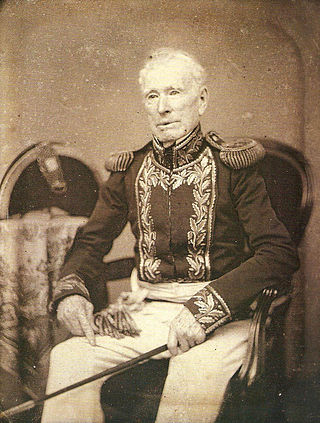
William Brown was an Irish sailor, merchant, and naval commander who served in the Argentine Navy during the wars of the early 19th century. Brown's successes in the Argentine War of Independence, the Cisplatine War, and the Anglo-French blockade of the Río de la Plata earned the respect and appreciation of the Argentine people, and he is regarded as one of Argentina's national heroes. The creator and first admiral of the country's maritime forces, he is commonly known as the "father of the Argentine Navy".

The Argentine Navy is the navy of Argentina. It is one of the three branches of the Armed Forces of the Argentine Republic, together with the Army and the Air Force.
The Brazilian Navy is the naval service branch of the Brazilian Armed Forces, responsible for conducting naval operations.

ARA Almirante Irízar is a large icebreaker of the Argentine Navy. She was ordered from a shipyard in Finland in 1975.

USS Braine (DD-630), a Fletcher-class destroyer, was a ship of the United States Navy named for Rear Admiral Daniel L. Braine (1829–1898), who served in the American Civil War. Constructed by Bath Iron Works in Bath, Maine, the ship was launched on 7 March 1943 and commissioned on 11 May 1943. The destroyer took part in the United States' naval campaign in the South Pacific during World War II. Following the war, the vessel was decommissioned and placed in reserve. During the Korean War, Braine was recommissioned and operated in the Mediterranean Sea before being decommissioned for the final time by the United States Navy in 1971. The destroyer was sold to Argentina and renamed ARA Almirante Domecq Garcia after Admiral Manuel Domecq Garcia and served with the Argentinian Navy until disposed of as a target ship in 1983.

ARA Almirante Domecq Garcia (D23) was a Fletcher-class destroyer which served with the Argentine Navy from 1971 to 1983.

ARA Patagonia (B-1) is a multi-product replenishment oiler of the Durance class in service in the Argentine Navy. She was the lead ship of her class serving in the French Navy as Durance from 1977 to 1999. In French service, the ship served with the Force d'action navale. In Argentine service the vessel is used in multi-national naval exercises and supplies the Antarctic missions operating from Ushuaia. In 2017, Patagonia was used to search for the missing submarine ARA San Juan.

Port Belgrano Naval Base is the largest naval base of the Argentine Navy, situated next to Punta Alta, near Bahía Blanca, about 560 km (348 mi) south of Buenos Aires. It is named after the brigantine General Belgrano which sounded the area in late 1824.

The Almirante Brown class is a class of warships built for the Argentine Navy. They were commissioned between 1983 and 1984, after the Falklands War. The class comprised four ships; Almirante Brown, La Argentina, Heroína and Sarandí. Heronia was retired in 2024 after a period of prolonged inactivity.
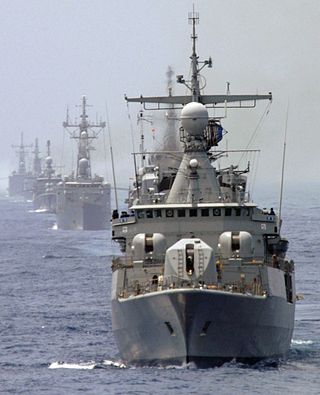
ARA Almirante Brown is the lead ship of the MEKO 360H2 series of four destroyers built for the Argentine Navy. The ship is the ninth ship in the history of the Argentine Navy to be named for Admiral William Brown, the founder and commander of the Argentine Navy during Argentina's war of independence against Spain.

ARA Sarandí is the fourth and last ship of the MEKO 360H2 series of destroyers built for the Argentine Navy. The ship is also the fourth ship in the Argentine Navy to bear that name. Sarandí is the name of a victory of the Argentine army during the Cisplatine War.

ARA Espora (P-41) is the lead ship of the MEKO 140A16 Espora class of six corvettes built for the Argentine Navy. Commissioned in 1985, she is used for fishery patrol. She is homeported at Puerto Belgrano Naval Base and is part of the Navy's 2nd Corvette Division with her five sister ships. The ship is the sixth ship to bear the name of Colonel (Navy) Tomás Espora, who fought in the Argentine Navy during the Cisplatine War. Generator failure left her stranded in South Africa for 73 days in late 2012.

ARA Rosales (P-42) is the second ship of the MEKO 140A16 Espora class of six corvettes built for the Argentine Navy. The ship is the fourth ship to bear the name of Colonel (Navy) Leonardo Rosales, who fought in the Argentine Navy during Argentina's war of independence and the Cisplatine War.
Several ships of the Argentine Republic Navy have been named Almirante Brown, General Brown, or Brown after William Brown (1777–1857), father of the Argentine Navy.
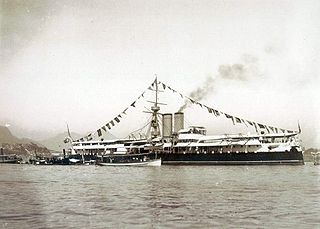
Riachuelo was a Brazilian ironclad battleship completed in 1883. She was named in honour of the Battle of Riachuelo in 1865. Built in the United Kingdom, the ship entered service with the Brazilian Navy in 1883 and remained in service until 1910.
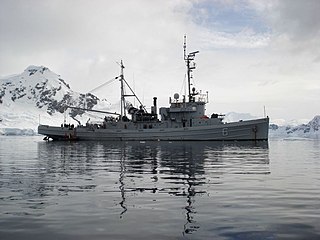
ARA Suboficial Castillo (A-6) was an Abnaki-class tug/patrol boat of the Argentine Navy. She previously served in the United States Navy as USS Takelma (ATF-113) from 1944 to 1992. The ship was acquired by Argentina in 1993 and was in service until the 2020s. In 2022, the ship was put up for sale. Suboficial Castillo was used as support ship for both the Argentine Submarine Force and during the summer campaigns in Antarctica in the Patrulla Antártica Naval Combinada with the Chilean Navy to guarantee safety to all touristic and scientific ships that are in transit within the Antarctic Peninsula.
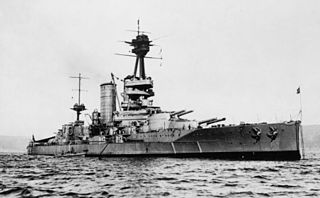
The Almirante Latorre class consisted of two super-dreadnought battleships designed by the British company Armstrong Whitworth for the Chilean Navy. They were intended to be Chile's entries to the South American dreadnought race, but both were purchased by the Royal Navy prior to completion for use in the First World War. Only one, Almirante Latorre (HMS Canada), was finished as a battleship; Almirante Cochrane (HMS Eagle), was converted to an aircraft carrier. Under their Chilean names, they honored Admirals (Almirantes) Juan José Latorre and Thomas Cochrane; they took their British names from what was then a dominion of Canada and a traditional ship name in the Royal Navy.

The Brazilian Antarctic Program is a program of the Brazilian Navy which has presence in the continent of Antarctica. It coordinates research and the operational support for research in the region. It currently maintains a year-round research station in Antarctica, as well as several seasonal field camps. It also maintains two research vessels that sail in the Antarctic waters.

The Brown-class destroyer is a class of destroyers of the Argentine Navy. Five ships of the Fletcher class were lent by the United States Navy and were in commission from 1961 until 1982.
On 15 November 2017, the Argentine submarine ARA San Juan disappeared in the South Atlantic off the coast of Argentina while on a training exercise. After a search lasting 15 days, the Argentine Navy downgraded the operation from a rescue mission to a search for the submarine's wreck, implying they had given up hope of finding survivors among its crew of 44. It was the worst submarine disaster since the accident on Chinese submarine 361 in 2003, and the second worst peacetime naval disaster in Argentina after the 1949 sinking of the minesweeper ARA Fournier.
















